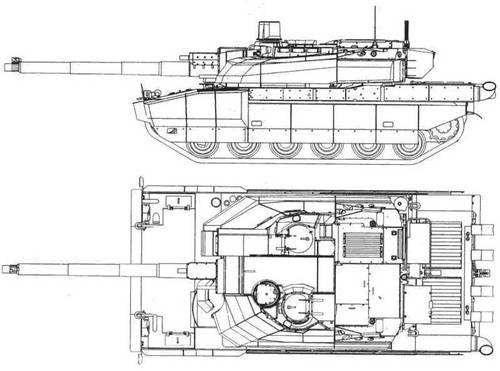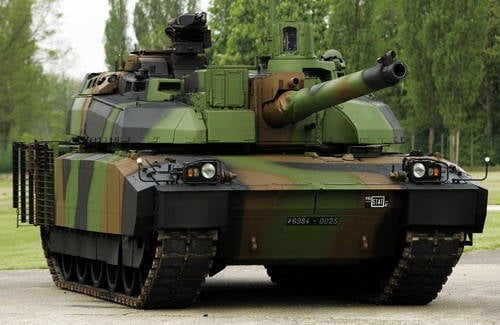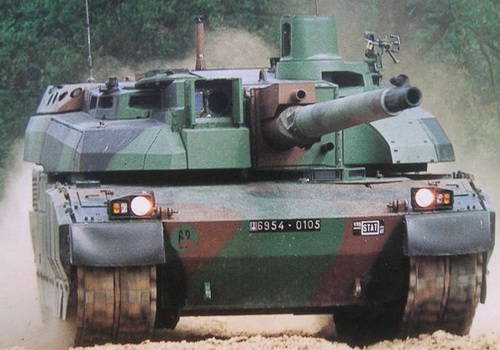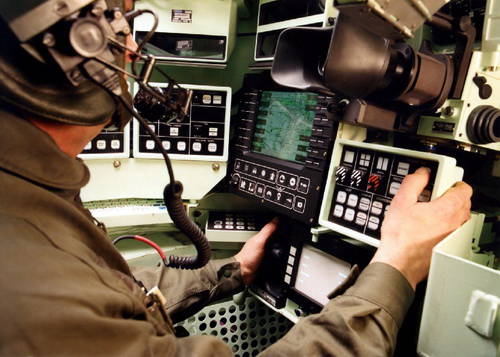Western main battle tanks (part of 1) - Leclerc
We start our story with the least well-known in Russia, but at the same time the most modern and promising tank of the current time - the French Leclerc, which some experts already now refer to the 3 + generation, and even to a completely new, 4 generation of tanks.
Development of the MBT of France was carried out in several stages. In 1978-1982, research was carried out in the field of concepts and general characteristics, the model was developed from 1982 to 1986 for a year, and experimental samples were created and tested in 1986 to 1991 a year.
In January 1992, the first serial "Leclerc", manufactured at the enterprises of the national firm GIAT, entered service with the French army. According to the results of tests conducted in 1993, the tank was finally put into service. In the 1993 year, it was planned to manufacture 13 machines, and by the end of the 1995 year - 60 (to staff one brigade). In total, until the end of 2000, the French Ministry of Defense planned to get 850 of such tanks. However, due to changes in the foreign policy situation (end of the Cold War), as well as due to the prohibitively high cost of the tank, the order was reduced first to 800, and then completely to 406 tanks. In 1993, GIAT concluded a contract with the UAE for the supply of 390 tanks Leclerc and 46 BREM based on it, the contract was executed in 1999 year.

"Leclerc" is made according to the traditional, which has become a classic scheme, with the front control compartment and the rear engine-transmission compartment. The combat weight of "Leclerc" in comparison with other MBT of Western countries is relatively small - only 55 tons. At the same time, many decisions concerning the layout of the internal systems and crew accommodation were applied on it for the first time. Thus, the crew members of the tank are practically isolated from each other, there is no loader, instead of it, an automatic loader is installed on the tank, and the way of placing the gun in the tank is not typical.
In accordance with the classic layout, most of the crew is located in an armored turret of circular rotation. The crew consists of three people, the tank commander is located in the bash to the left of the gun, the gunner is on the right. An automatic loader (AZ) is installed in the back of the tower, an armored partition is installed between it and the fighting compartment. The driver is located in the forward part of the hull with a small displacement of the workplace to the left side of the tank. Due to the layout, all crew members are practically isolated from each other and from the gun with AZ, which increases the effectiveness of the crew’s protection against weapons mass destruction and reduces gas pollution in the habitable space of the tank when fired.
Due to the use in the design of the tank AZ and a compact power plant (having a capacity of 1500 hp, the engine displacement does not exceed the engine capacity of the AMX-30 tank, which developed only the 750 hp), the internal volume of the tank hull was significantly reduced compared with other models of Western technology, and the length of the chassis has been reduced by almost a meter. As a result, the combat weight of the tank does not exceed 55 tons (for Abrams М1А2 - 62,5 т.), And the specific engine power is 27,5 hp per ton, which allows the tank to get off the ground to accelerate to 32 km / h in 5,5 seconds, while the speed on the highway can reach 72 km / h.

The Lecler’s main weapon is the 120-mm smoothbore gun CN-120-26 with a total length of 7,1 m and a barrel length of 52 caliber. The tank gun is stabilized in two planes. The barrel and breech of the gun are combined into a armored block that is built in the middle of the tower and divides the fighting compartment into two halves. Because of the placement of the gun in a special box in which the trunnions are fixed, its installation and disassembly is carried out together with the box without removing the tank tower. The ammunition of the gun consists of 40 unitary art blows with a burning sleeve. 22 projectile immediately located in the automatic loader. The gun's rate of fire is 15 shots per minute, in real combat conditions, the figure drops to 10-12 shots.
The gun mounted on the Leclerc is considered the most powerful among all 3-generation tanks, surpassing the German Rh-120 / L44, its American version of the M256 and the Soviet 2-XXUMXM. However, along with high performance, this tool also has a number of significant drawbacks: high cost, manufacturing complexity, relatively short barrel life - 46 shots. Thanks to the wide embrasure of the turret, a more powerful 400-mm gun can be installed on the tank in the future.
The creators of the French tank chose the widely used “Halix 13” multifunctional smoke grenade launcher, which consists of two 9 units of 80-mm grenades on both sides of the tower (4 smoke, 2 infrared traps for jamming anti-tank guided laser beam , 3 high-explosive fragmentation to destroy enemy infantry). The smoke grenade is fired at 30-50 meters, forming a smoke screen in the sector up to 120 degrees. An anti-personnel grenade at blasting forms about 1000 fragments weighing up to 0,2 grams, flying at a speed of 1600 m / s. Anti-personnel grenades are fired at a distance of 15 meters and hit enemy infantry at the side or rear of the tank, at a distance of up to 30 meters. Grenades heat traps interfere with anti-tank missiles equipped with thermal homing heads.
The fire control system (LMS) of Leclerc is as follows:
- sights of gunner and commander, equipped with laser range finders;
- thermal imaging camera;
- 8 periscope surveillance devices for the commander;
- an onboard automatic meteorological station capable of determining atmospheric pressure, wind speed and direction, air temperature;
- system of dynamic matching of the line of sight with the axis of the bore of the gun;
- weapon stabilizer in two planes;
All elements included in the MSA are closed on a computer, which calculates the data for firing, is able to make the necessary corrections, as well as to monitor the operation of the systems and units of the tank. The time it takes to bring the SLA into a combat position is 1 a minute since the computer was turned on.

Commander two-channel sight has a stable field of view. The firing channel has 2-e magnification, which allows the tank commander to detect targets at a distance of 4600 meters. The target detection range for a passive-type night vision channel is half a kilometer. The sight allows the tank commander to independently fire from a cannon and a machine gun paired with her or to give target designation to the gunner of the gun. The head part of the gunner's sight is rigidly mounted in the armor of the gun, and the ocular part is installed in the tower. The sight is stabilized in two planes. On each of the commander's periscopic 8 sights, there is a targeting button, clicking on which the tank gun automatically points to the line of sight of this observation device.
Computer OMS has the ability to automatically enter the necessary amendments to the scope. The Leclerc's weapons stabilizer uses turret and gun electric drives (hydraulic systems and units were completely excluded from the tower design to reduce the likelihood of a fire). The gun stabilizer allows you to fire in motion over rough terrain at a speed of 36 km / h, and the speed of movement of the targets being hit may exceed 72 km / h. The turret of the tank is equipped with an autonomous emergency power supply system, which is powered by batteries. Accumulators also provide power to the units and instruments of the FCS with the engine off.
In addition to the electronic system of the FCS, a second on-board computer is installed on the tank, which controls other systems of the combat vehicle and, if necessary, can perform the functions of the PC MSA. The on-board computer includes control units for the automatic loader, gearbox, engine, fire protection system, protection systems against the effects of weapons of mass destruction, etc. The tank has a navigation system, a VHF radio station, which is capable of transmitting voice reports and information in graphic and digital forms.

All of these components are part of a tank information management system (TIUS), which is combined with a single regimental combat control system. It is capable of automatically transmitting to the regimental command post or commander of a unit all formalized data on the direction of movement of the tank, fuel consumption and ammunition, and its location. This system accepts orders and orders and brings them to the commander of the combat vehicle. A similar system is currently being mounted on American Abrams tanks.
The main feature of Leclerc, which allows some specialists to refer it to the 4 generation MBT, is a fundamentally new level of information integration and computerization. All electronic systems of the tank form a single tank information management system (TIUS). Information from it is displayed on multifunctional monitors. Electronics controls the operation of the transmission, engine, weapons and other components, fixing all the problems and giving information to the crew. Two radio stations, a satellite positioning system and a computer optimally include the tank in a combat situation, giving the command vast opportunities for coordination and communication.
Sales of this tank abroad turned out to be quite modest, but first of all the price was influenced here. The only importer of the UAE steel tank. It is not surprising, because the price of one machine varies at the level of 10 million dollars, which is a record in tank building. According to some information, 60% of this value is formed at the expense of TIUS. For comparison: similar OBT, for example, Type-90 costs the Japanese government 8-9 million, Israeli Merkava-4 and American М1А2 SEP are estimated at 6-7 million, German Leopard-2Х6 » 4-5 million dollars, well, the price of the Russian T-90С is only 1,3-1,8 million dollars.
Information